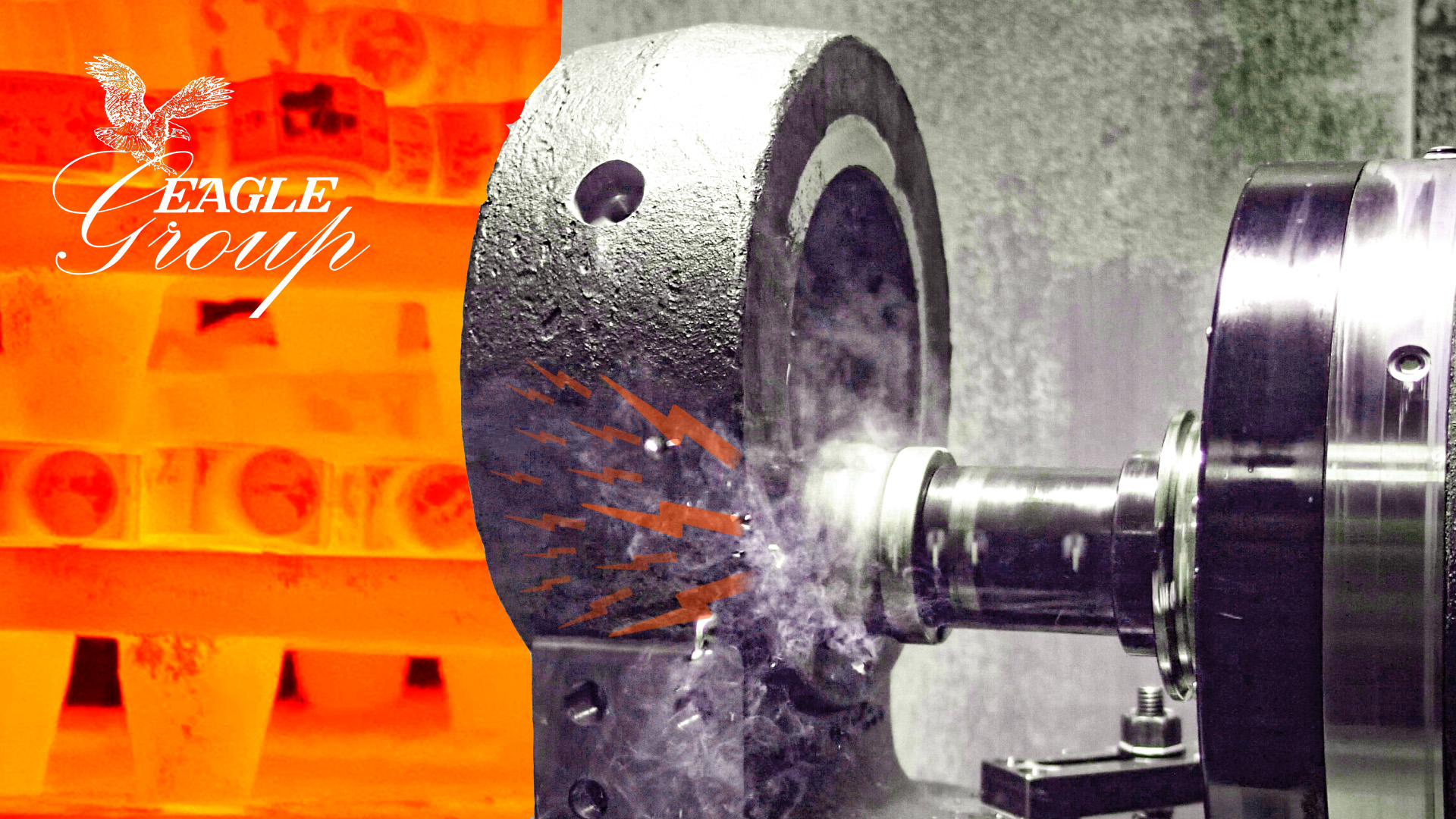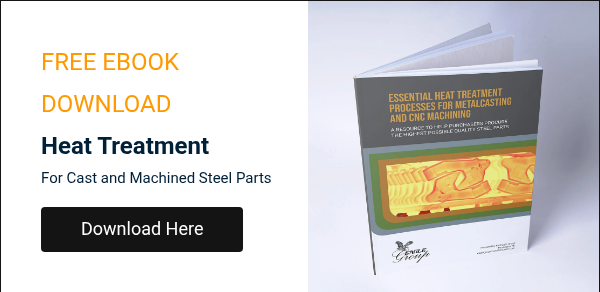Heat Treatment: Stress Relief

Internal stresses form naturally during many manufacturing processes. Machining, stamping and welding, for example, are common manufacturing methods that augment the amount of stress in a material’s fabric. And although stress build-up is a natural byproduct of these processes, too much of it leads very commonly to part distortion. Most of these stresses must therefore be removed before a part can be considered ready and safe to use. Thanks to heat treatment, these stresses can be relieved (without changing a part’s mechanical properties) through a thermal process known as stress relieving.
Machining and Stress Relieving
Machining is one of the most common post-processing activities for cast parts, and many of the Eagle Group’s parts undergo machining at some point in their manufacturing timeline. Machining comprises a slew of mechanically intense operations, and the energy and application of these processes leave material stresses in their wake. These are known as residual stresses, and they persist to some degree after any machining job.
Given the amount of machining we do (as well as occasional weld repair, which we will also cover briefly), we have to pay careful attention to the amount of unwanted stress that builds up during manufacturing. In this article, we’ll be discussing how machine shops use specific heat treatment processes to eliminate stresses that could otherwise cause distortion in finished parts.
Defining Stress Relief in Manufacturing
In the world of heat treatment, there are a few different methods for resetting the stress levels in a material. However, the job of stress relieving, strictly speaking, is to eliminate residual stresses while ensuring the basic microstructure and associated mechanical properties remain unchanged.
This means that while similar heat treatments (like annealing, tempering, or normalizing) can be used to eradicate leftover stresses, they will also change the microstructure – and therefore mechanical and physical properties – of a material. In particular, tempering is used to relieve internal stresses by rearranging an alloy’s microstructure after quench hardening. When stress relieving, on the other hand, we are working with much lower temperatures (roughly half as hot as tempering). The lower temperature gives just enough thermal input to allow the atoms impacted by stress to move around and resettle in a more stable arrangement.
This distinction is very important in the machining world because machine shops commonly receive material to be machined in a state known as "heat delivered," which means the stock is already tuned to the right mechanical and physical properties. And because we don’t want to change that tuning, we have to stress relieve materials carefully to ensure the alloy’s properties remain unchanged. Only stress relieving can reset stresses without altering properties.
The Importance of Stress Relieving in Manufacturing
The thermal laws of stress relieving are applicable to both castings that have been machined, and to parts that have been fully machined from bar stock or billet. As such, stress relieving is widely practiced as an industry standard.
As mentioned above, machining jobs are intense mechanical operations, and therefore machining leaves behind residual stresses in the fabric of the manufactured material. Stress relief is used to stabilize these stresses, ensuring uniform mechanical properties across a specific section, or across an entire part.
Machining facilities have various tools at their disposal to minimize the quantity and severity of residual stresses: techniques such as using appropriate cutting tools, proper clamping techniques, and consistently even cutting (to name just a few). Still, even after following best practices, some degree of stress is inevitable and, if left uncorrected, can result in measurable distortions across the part. Part distortion is very undesirable: worst case scenario, a part that hasn’t been stress relieved could fracture. But unrelieved parts can also simply go out of tolerance, potentially resulting in factory returns or even causing operational issues in the field. Practically speaking, stress relieving boosts a part’s resistance to volatile pressure and temperature changes, because it’s these variables that often cause distortion in non-stress-relieved parts.
Since CNC machining is the industry standard to achieve extremely tight tolerances, post-manufacturing distortion is not admissible. By applying proper heat treatment, machine shops make sure the tolerances specified by customers remain intact.
Looking for an in-depth guide on essential heat treatment processes like stress relief for metalcasting and CNC machining?
Click below, fill out a brief form, and get your free ebook instantly.
How Machining Generates Stress
Mechanical, Thermal, and Chemical Stress
The two most common mechanical stresses produced by machining are tensile and compressive stress. These two stresses together fall under the category of normal stress: this is because the force causing the stress is acting perpendicular to the surface of the object (a common spatial relationship between CNC machines and the workpiece). The difference between the two is as follows:
- Tensile
- The stress that results from a material being pulled in opposite directions.
- Compressive
- The resistance of opposite ends of a material to be compressed towards each other (like crushing a can).
Although mechanical stresses are the most prevalent cause of distortion, they are not the only stresses we have to be sure to correct. There are also thermal and chemical stresses: thermal stresses are the result of the heat and friction of the machining tools on the material, while chemical stresses arise from reactions between the cutting fluids and the material. These, too, will be ironed out over the course of a stress relieving treatment.
How Welding Causes Stress
Welding is a common process in fabrication. While metalcasting and machining can produce complete parts without the need to assemble through welding, there are occasional exceptions. Casting facilities also sometimes employ weld repair to fix minor casting defects while maintaining identical performance. For more on weld repair, or production welding, check out our post series here.
From a stress relief perspective, localized welding can cause distortions due to the uneven heating and cooling between the base metal and the weld metal. As they cool at different rates, their thermal contraction also happens at different rates and can result in deformations that cause distortion.
Like with responsible machining, trusted welding techniques can be used to minimize or at least redistribute some of the stresses to other areas of the part, including: avoiding overly concentrated weldments, using the correct welding method for the given material, or pre-heating the base metal, to give a few popular examples.
Still, taking all necessary precautions to minimize residual stresses rarely produces an adequately unstressed material. Here, too, stress relieving becomes an important part of the process.
Thermal Recipes for Stress Relieving
Stress relieving requires heating a material to below its lower transformation temperature. When we talk about transformation temperatures in the context of heat treatment, we refer to two different temperatures: the higher transformation temperature, and the lower transformation temperature; the lower temperature is the temperature at which the steel grains start to austenitize. Above what’s known as the higher transformation temperature, the entire steel piece is austenitized throughout. What’s important for stress relieving is that we keep the material below the lower transformation temperature.
The distinction between the lower and upper critical temperatures is important to bear in mind when thinking about heat treatment in general: for a lengthier discussion of the difference, head to our Heat Treatment Introduction blog.
The lower and upper critical temperatures vary by alloy. As such, there is no single prescription for an effective stress relief. In deciding on the appropriate temperature, as well as holding time and quenching methods, manufacturers must take into account the alloy as well as the part dimensions. To quote DeGarmo’s Material and Processes in Manufacturing:
“Times and temperatures vary with the condition of the component, but the basic microstructure and associated mechanical properties generally remain unchanged.” Black, JT., & Kohser, Ronald A. (2019). DeGarmo’s Materials and Processes in Manufacturing (13th Edition). John Wiley & Sons, Inc (pg. 69)
Fortunately, ASTM International provides detailed temperature guidelines that can inform anyone embarking on a heat treatment journey with a new part. To learn more about how the Eagle Group makes use of ASTM standards, check out our Introduction to Heat Treatment post.
Stress relief’s place in the overall order of manufacturing operations also depends on the part. For example, when roughing machining processes that remove large amounts of material are involved, stress relief generally comes afterwards. But finishing processes like grinding and polishing can take place after stress relief. For a more detailed discussion on the importance of sequence and timing of heat treatment in the machining process, head to our dedicated post on Eagle CNC.
Stress Relieving and Related Heat Treatments
Technically, annealing and tempering are both methods for relieving stress, and the processes are similar to the type covered in this post. The principal difference is the temperature to which the materials are heated: typically, annealing and tempering both require higher temperatures than simple stress relieving.
An important distinction lies in the fact that when we are annealing or tempering, we are generally working with material that has been hardened, often through transformation hardening. In these processes, we are simultaneously looking to increase the toughness and ductility of a material.
Although normalizing, annealing, tempering and stress relieving will all eliminate many of the residual stresses in a material, stress relieving is the only process designed to leave the microstructure and mechanical properties unchanged. Thus, stress relieving must be conducted carefully: if a material gets heated even slightly above its lower transformation temperature, the result will often be a workpiece with altered mechanical and physical properties.
Stress relief is paramount to the overall quality and reliability of manufactured parts, especially fabricated and machined parts. Since most cast parts we produce undergo some form of machining, stress relief is a key heat treatment process for all Eagle Group companies. As an industry standard, stress relieving is an essential practice that, along with careful machining and welding techniques, significantly contributes to the longevity and performance of cast and machined parts.
Learn More About Heat Treatment in Our Dedicated Series
Tags: Processes, Metallurgy, Heat Treatment

Written by Jason Bergman
Jason Bergman is Senior Quality Engineer and Metallurgist at Eagle Alloy. He has been with the company since 2013.




